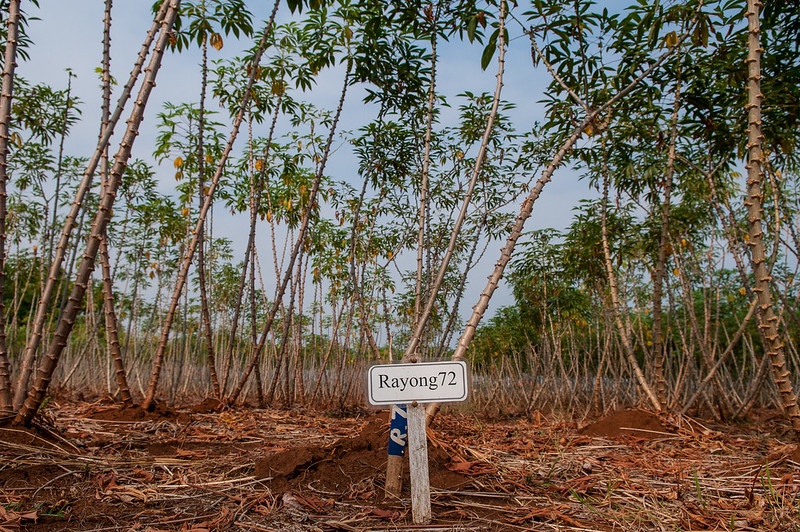ដំណាំជីវឥន្ធនៈមានសក្តានុពលគួរឱ្យកត់សម្គាល់ ក្នុងការរួមចំណែកដល់តម្រូវការថាមពលនាពេលអនាគតនៅទូទាំងពិភពលោក។ ដីកសិកម្មបានផ្តល់ឱ្យនូវជម្រើសក្នុងការដាំដុះដំណាំជីវឥន្ធនៈជំនួសផលិតកម្មអាហារដែលមានលក្ខណៈសាមញ្ញ។ ដំណាំជីវឥន្ទនៈ គឺជាមធ្យោបាយផលិតកម្មថាមពលប្រកបដោយនិរន្តរភាពដ៏មានតម្លៃ និងគិតគូរដល់បរិស្ថាន។1 តម្រូវការប្រេងឥន្ធនៈសម្រាប់វិស័យដឹកជញ្ជូននៅកម្ពុជាកំពុងតែកើនឡើង ស្របពេលការយល់ដឹងអំពីតម្លៃបរិស្ថាននៃឥន្ធនៈផូស៊ីលកំពុងតែកើនឡើង និងគួរឱ្យបារម្ភ។ ដោយសារតែមានដីទំនេរដែលមានសក្តានុពល ការផលិតជីវឥន្ធនៈផ្តល់នូវឱកាសដែលគួរឱ្យចាប់អារម្មណ៍ និងទាក់ទាញសម្រាប់ប្រទេសកម្ពុជា។2
ការដាំដុះដំណាំដែលអាចផលិតជីវៈអេតាណុលបានរួមមានអំពៅ និងល្ហុងខ្វងកំពុងតែមានការកើនឡើង។3 ហេដ្ឋារចនាសម្ព័ន្ធថាមពលដែលមានស្រាប់នៅប្រទេសកម្ពុជា និងអត្រានៃដំណាំល្ហុងខ្វងដែលជាដំណាំជីវៈម៉ាស៊ូតសំខាន់មួយទៀតក្នុងចំណោមដំណាំជីវៈម៉ាស៊ូតទាំងអស់ ធ្វើឱ្យជីវៈម៉ាស៊ូតក្លាយជាជម្រើសដែលស្ថិតស្ថេរជំនួសឱ្យឥន្ធនៈផូស៊ីល។4 នៅក្នុងឆ្នាំ ២០១៧ ការផ្គត់ផ្គង់ជីវឥន្ធនៈមានចំនួន ៩០ភាគរយ នៃប្រភពថាមពលដែលកកើតឡើងវិញ ប៉ុន្តែជីវឥន្ធនៈប្រើប្រាស់សម្រាប់ថាមពលអគ្គិសនីដែលកកើតឡើងវិញមានតែ ៣ភាគរយតែប៉ុណ្ណោះនៅក្នុងឆ្នាំ ២០១៩។5 ភាពខុសគ្នានេះអាចឆ្លុះបញ្ចាំងពីការពិតដែលជីវឥន្ធនៈត្រូវបានប្រើប្រាស់ជាលក្ខណៈគ្រួសារតាមបែបប្រពៃណី ហើយមិនត្រូវបានប្រើប្រាស់ក្នុងទំហំពាណិជ្ជកម្ម ដើម្បីផលិតអគ្គិសនីនោះទេ។
ជីវឥន្ធនៈបានផលិតចេញពីការបំលែងជីវម៉ាសទៅជាប្រេងរាវ ឬឧស្ម័ន។ ជីវឥន្ធនៈរាវអាចត្រូវបានលាយ ឬប្រើប្រាស់ជំនួសឥន្ធនៈផូស៊ីល។ ជីវឥន្ធនៈមានបីទម្រង់ដូចជា ប្រេងបន្លែ ជីវៈអេតាណុល និងជីវៈម៉ាស៊ូត។
- ប្រេងបន្លែ៖ ទោះបីជាវាងាយស្រួលក្នុងការផលិតនៅកម្ពុជាក៏ដោយ ក៏ប៉ុន្តែវាមិនសមស្របនោះទេ ដោយសារតែការប្រើប្រាស់របស់វាទាមទារឱ្យមានការកែប្រែម៉ាស៊ីន។
- ជីវៈអេតាណុល៖ ត្រូវបានផលិតចេញពីការឡើងមេនៃជីវម៉ាសដែលមានសារធាតុកាបូអ៊ីដ្រាតខ្ពស់ដូចជា អំពៅ និងល្ហុងខ្វង។ ជារឿយៗ វាត្រូវបានលាយជាមួយនឹងឥន្ទនៈផូស៊ីល ហើយអាចប្រើប្រាស់ក្នុងទម្រង់ដើមនៅក្នុងយាន្តយន្តដែលអាចបត់បែងការប្រើប្រាស់ឥន្ទនៈបាន។
- ជីវៈម៉ាស៊ូត៖ ត្រូវបានផលិតចេញពីប្រេងបន្លែ ដោយការប្តូរ និងអនុលោមតាមស្តង់ដារពាណិជ្ជកម្ម។ ជីវៈម៉ាស៊ូតមានលក្ខណៈគីមី និងរូបស្រដៀងនឹងប្រេងម៉ាស៊ូត ហើយអាចប្រើប្រាស់នៅក្នុងម៉ាស៊ីនម៉ាស៊ូតដោយគ្មានការកែប្រែ។
តម្លៃឥន្ធនៈផូស៊ីលខ្ពស់ធ្វើឱ្យការផលិតជីវឥន្ធនៈក្លាយជាជម្រើសដ៏ទាក់ទាញមួយនៅក្នុងប្រទេសកម្ពុជា។6
ដូងប្រេង
ដោយពិចារណាទៅលើលក្ខខណ្ឌ និងតម្រូវការនៃដំណាំជីវឥន្ធនៈ ដីដែលសមស្របសម្រាប់ដាំដំណាំទាំងនេះនៅមានដែនកំណត់នៅឡើយ។ ដំណាំដូងប្រេងត្រូវការអាកាសធាតុព្រៃត្រូពិចដែលមានភ្លៀងធ្លាក់ប្រចាំឆ្នាំជាង ៣.០០០មីលីម៉ែត្រ ដូចនេះមានខេត្តពីរប៉ុណ្តោះដែលសមស្រប គឺខេត្តកោះកុង និងខេត្តព្រះសីហនុ ដែលមានភ្លៀងធ្លាក់ប្រមាណ ៣.៥១២មីលីម៉ែត្រ និង២.៩៣៧មីលីម៉ែត្រ សមាមាត្រគ្នាក្នុងមួយឆ្នាំ។

ផ្លែដូងប្រេងត្រៀមសម្រាប់ដំណើរការកែច្នៃ។ រូបភាព ដោយ Center for International Forestry Research (CIFOR) ថតនៅថ្ងៃទី១៣ ខែសីហា ឆ្នាំ២០០៩។ ក្រោមអាជ្ញាបណ្ណ CC BY-NC-ND 2.0។
ល្ហុងខ្វង
ការដាំល្ហុងខ្វងមិនមានការលំបាកនោះទេ គឺវាត្រូវការទឹកភ្លៀងប្រមាណតែ ៣០០ ទៅ ១.៥០០មីលីម៉ែត្រក្នុងមួយឆ្នាំតែប៉ុណ្ណោះ ខណៈដែលកម្ពុជាមានភ្លៀងធ្លាក់ជាមធ្យម ១.០០០ ទៅ ១.៥០០មីលីម៉ែត្រក្នុងមួយឆ្នាំ។ ល្ហុងខ្វងត្រូវបានដាំនៅក្នុងខេត្តកំពង់ស្ពឺ បាត់ដំបង បន្ទាយមានជ័យ ព្រៃវែង សៀមរាប កំពត កែប និងខេត្តមួយចំនួនទៀត។ ដំណាំអំពៅត្រូវការប្រព័ន្ធធារាសាស្ត្រ ដូចនេះកន្លែងដែលអាចដាំដុះបានត្រូវតែអាចប្រើប្រាស់ប្រព័ន្ធធារាសាស្ត្រ ឬមានទឹកគ្រប់គ្រាន់។7
ថាមពលដែលផ្ទុកនៅក្នុងប្រេងល្ហុងខ្វង មានលក្ខណៈស្រដៀងគ្នាទៅនឹងប្រេងម៉ាស៊ូត ហើយជីវៈម៉ាស៊ូតដែលផលិតចេញពីវាអាចប្រើប្រាស់ដោយផ្ទាល់នៅក្នុងម៉ាស៊ីនម៉ាស៊ូតភាគច្រើន។ ផលិតកម្មប្រេងល្ហុងខ្វងសម្រាប់ជីវឥន្ធនៈត្រូវបានរារាំងដោយសារកង្វះបច្ចេកវិទ្យាសមស្រប និងភាពបរាជ័យក្នុងកម្មវិធីវិនិយោគ។8 ទោះបីជាយ៉ាងណា ភូមិមួយចំនួននៅតាមតំបន់ជនបទនៅតែប្រើប្រាស់ប្រេងល្ហុងខ្វងជាប្រភពនៃថាមពល។ ប្រជាជន ៨០គ្រួសារ នៅក្នុងស្រុកបាងត្រែង និង៣៦០គ្រួសារនៅក្នុងស្រុកពយចៀ ខេត្តបន្ទាយមានជ័យ ប្រើប្រាស់អគ្គិសនីពីបណ្តាញអគ្គិសនីខ្នាតតូចដែលផលិតចេញពីប្រេងល្ហុងខ្វង។9

មែកសុទ្ធតែផ្លែរបស់ដើមល្ហុងខ្វងដែលបានដាំដុះដោយធម្មជាតិនឹងប្រើប្រាស់ដើម្បីចម្រាញ់ជាជីវឥន្ធនៈ។ រូបភាព ដោយ Ton Rulkens, ថតនៅថ្ងៃទី ០១ ខែឧសភា ឆ្នាំ២០០៩។ ក្រោមអាជ្ញាបណ្ណ CC BY-SA 2.0។
ដំឡូងមី
ដំឡូងមី គឺជារុក្ខជាតិដែលផ្ទុកកាបូអ៊ីដ្រាតខ្ពស់ និងអាចរស់រានបាននៅពេលមានគ្រោះរាំងស្ងួត និងដីគ្មានជីជាតិ ក្នុងចំណោមដំណាំស្បៀងរបស់ប្រជាជនក្រីក្រក្នុងតំបន់ត្រូពិច និងអនុតំបន់ត្រូពិច។ រុក្ខជាតិប្រភេទនេះក៏មានបញ្ហាជាមួយនឹងពពួកសត្វល្អិត និងជំងឺនៅពេលដាំដុះនៅអាស៊ីអាគ្នេយ៍ផងដែរ។10 ជាប្រពៃណីនៃការដាំដុះនៅក្នុងគ្រួសារដែលមានជីវភាពក្រីក្រ ដំឡូងមីមានការលំបាកក្នុងការដាំដុះក្នុងលក្ខណៈទ្រង់ទ្រាយធំ ព្រោះវាត្រូវបានដាំពីការកាត់ដើម ដែលពិបាកក្នុងការថែទាំ និងរក្សាទុក។ ការដាំដុះដំឡូងមីពឹងផ្អែកលើកម្លាំងពលកម្មច្រើនផងដែរ។ តម្រូវការកើនឡើងនៃដំឡូងមីនៅទូទាំងពិភពលោក ត្រូវបានគេរំពឹងថានឹងនាំទៅរកការផ្លាស់ប្តូរបច្ចេកវិទ្យាក្នុងការដាំដុះឬស។11 សព្វថ្ងៃនេះ ដំឡូងមីត្រូវបានដាំដុះនៅខេត្តបាត់ដំបង ប៉ៃលិន បន្ទាយមានជ័យ ក្រចេះ និងកំពង់ធំ។ វាត្រូវបានដាំនៅខែឧសភា និងប្រមូលផលនៅចន្លោះខែវិច្ឆិកា និងចុងខែកុម្ភៈ ជារៀងរាល់ឆ្នាំ។12

ដំឡូងមីដែលមានសុខភាពល្អនៅដីឡូតិ៍CIATក្នុងប្រទេសកម្ពុជា។ រូបភាពដោយ CIAT ថតនៅថ្ងៃទី២៥ ខែមីនា ឆ្នាំ២០១៤។ អាជ្ញាប័ណ្ណ CC BY-NC-SA 2.0។
ការចម្រាញ់ជីវឥន្ធនៈ
ប្រទេសកម្ពុជាមានដូងប្រេងសរុបប្រមាណ ១៦.០០០ហិកតា13 ល្ហុងខ្វង ១.០០០ហិកតា និងអំពៅ ២០.០០០ហិកតា។ បន្ថែមពីនេះ ជីវៈអេតាណុលប្រមាណ ៣៦លានលីត្រ ត្រូវបានផលិតចេញពីដំឡូងមីនៅក្រោមគម្រោងសហការក្រុមហ៊ុនកូរ៉េដែលមានឈ្មោះថា អិម អេស ជីវថាមពល គ្រុប។14 ប្រទេសកម្ពុជាមានសក្តានុពលគួរឱ្យកត់សម្គាល់ក្នុងការផលិតបរិមាណដ៏ច្រើនទាំងជីវៈម៉ាស៊ូត និងជីវៈអេតាណុលប្រមាណ ១៨២លានលីត្រ និង ២៥៧លានលីត្រ សមាមាត្រគ្នា។15
ក្រុមហ៊ុន ម៉ុង ឬទ្ធី គ្រុប គ្រោងនឹងសាងសង់រោងចក្រចម្រាញ់ប្រេងដូងឆៅដែលចំណាយប្រមាណ ១៦លានដុល្លារ នៅខេត្តព្រះសីហនុ ដើម្បីជំនួសរោងចក្រចម្រាញ់ប្រេងដែលមានសមត្ថភាពតូច។ កាលពីឆ្នាំ ២០១៣ ក្រុមហ៊ុនបានប៉ាន់ប្រមាណថា ផលិតកម្មប្រេងដូងឆៅនឹងកើនឡើងដល់ ២២.០០០តោន ហើយនៅឆ្នាំ ២០១៤ ដើមប្រេងដូងចំនួន ១៦.០០០ហិកតាត្រូវបានដាំ។16 នៅឆ្នាំ ២០២០ ទិន្នផលប៉ាន់ស្មានសម្រេចបានគឺ ២៧០.០០០តោន ប៉ុន្តែតួលេខអាចកើនដល់ ៣០០.០០០តោន។ ក្រុមហ៊ុន ម៉ុង ឬទ្ធី គ្រុប ធ្លាប់នាំចេញផលិតផលរបស់ខ្លួនទៅកាន់ប្រទេសថៃ និងម៉ាឡេស៊ី ប៉ុន្តែបច្ចុប្បន្ននេះគឺនាំចេញទៅកាន់ទីផ្សារអឺរ៉ុបវិញ។17 ធនធានអាស៊ីខាងជើងដែលមានមូលដ្ឋាននៅហុងកុងគ្រោងនឹងទិញដំឡូងមីប្រមាណ ១៤.០០០ហិកតា នៅខេត្តពោធិ៍សាត់ ក្នុងតម្លៃជាង ៥២លានដុល្លារ ដើម្បីផ្គត់ផ្គង់រោងចក្រផលិតអេតាណុល ១០០.០០០ពាន់តោនក្នុងមួយឆ្នាំ។18
ទោះបីជាអេតាណុលត្រូវបានផលិតនៅក្នុងប្រទេសកម្ពុជាដោយប្រើប្រាស់ផលិតផលដូចជា ដំឡូងមី និងអំពៅក៏ដោយ ប៉ុន្តែភាគច្រើនត្រូវបាននាំចេញ។ ឧទាហរណ៍ ក្រុមហ៊ុនកូរ៉េដែលមានឈ្មោះថា អិម អេស ជីវថាមពល គ្រុប បានផលិតអេតាណុលប្រមាណ ៣៦.០០០តោនក្នុងមួយឆ្នាំ ពីដំឡូងមីចំនួន ១០០,០០០តោន សម្រាប់នាំចេញទៅអឺរ៉ុប។19 ក្រុមហ៊ុនជប៉ុនមួយឈ្មោះថា អ៊ីម មីត ស៊ុយ និងហ្គាស បច្ចុប្បន្នកំពុងធ្វើការសិក្សា ដើម្បីបញ្ជាក់ថាតើរោងចក្រផលិតដំឡូងមីអាចត្រូវបានសាងសង់នៅក្នុងខេត្តបាត់ដំបងដែរឬទេ។20
ការអភិវឌ្ឍ និងបញ្ហាប្រឈមនានា
នៅកម្ពុជាមិនមានច្បាប់ជាក់លាក់ណាមួយ ដែលគាំទ្រដល់ការអភិវឌ្ឍជីវឥន្ធនៈនោះទេ។ ក្នុងនាមជាអ្នកចូលរួមនៃសន្ធិសញ្ញាក្យូតូ និងជាអ្នកគាំទ្រច្បាប់បរិស្ថានអន្តរជាតិដែលពាក់ព័ន្ធ ប្រទេសកម្ពុជាគាំទ្រដោយប្រយោលដល់ការអភិវឌ្ឍជីវឥន្ធនៈ ការកាត់បន្ថយភាពក្រីក្រ និងយុទ្ធសាស្ត្រការពារបរិស្ថាន ដែលដើរតួនាទីបម្រុងក្នុងការអភិវឌ្ឍជីវឥន្ធនៈ។21
គោលនយោបាយរបស់រដ្ឋាភិបាលទាក់ទងនឹងជីវឥន្ធនៈ ហាក់ដូចជាត្រូវបានបែងចែករវាងក្រសួងពីរគឺ ក្រសួងកសិកម្ម រុក្ខាប្រមាញ់ និងនេសាទ និងក្រសួងរ៉ែ និងថាមពល។ ជាផ្នែកមួយនៃផែនការរបស់ខ្លួនដើម្បីឆ្លើយតបនឹងតម្រូវការអគ្គិសនីនៅប្រទេសកម្ពុជា ក្រសួងមហាផ្ទៃនឹង “ជំរុញការអភិវឌ្ឍថាមពលកកើតឡើងវិញគ្រប់ប្រភេទដូចជា ជីវៈម៉ាស់ ជីវៈឧស្ម័ន ជីវឥន្ធនៈជាដើម”។ ក្នុងវិស័យស្រាវជ្រាវ និងអភិវឌ្ឍន៍កសិកម្ម ក្រសួងកសិកម្ម រុក្ខាប្រមាញ់ និងនេសាទ នឹង “...ធ្វើការស្រាវជ្រាវដើម្បីអភិវឌ្ឍបច្ចេកវិទ្យា និងវិធីសាស្ត្រឆ្ពោះទៅរកការគ្រប់គ្រងដីធ្លីប្រកបដោយនិរន្តរភាព និងកំណត់តម្រូវការជីវជាតិរុក្ខជាតិសម្រាប់ដំណាំជីវៈថាមពល”។22
អត្ថប្រយោជន៍ដែលមានសក្តានុពលពីការអភិវឌ្ឍ និងការប្រើប្រាស់ជីវឥន្ធនៈរួមមាន ការអភិវឌ្ឍសេដ្ឋកិច្ច អត្ថប្រយោជន៍បរិស្ថាន ការអភិវឌ្ឍជនបទ ការកាត់បន្ថយភាពក្រីក្រ23 កិច្ចសហប្រតិបត្តិការថាមពលសហគមន៍ សន្តិសុខថាមពល ការចូលរួមចំណែកក្នុងថាមពលកកើតឡើងវិញ និងយន្តការអភិវឌ្ឍន៍ស្អាត។24
ទោះជាយ៉ាងណាក៏ដោយ វាមានហានិភ័យ និងការព្រួយបារម្ភជាច្រើនទាក់ទងនឹងដំណាំជីវឥន្ធនៈ។ ការកើនឡើងនូវការលើកទឹកចិត្តក្នុងការវិនិយោគក្នុងចំណោមសាជីវកម្ម និងកង្វះប័ណ្ណកម្មសិទ្ធិរបស់ប្រជាជនកម្ពុជានៅតាមជនបទ ធ្វើឱ្យមនុស្សជាច្រើនប្រឈមនឹងហានិភ័យនៃការដណ្តើមយកដីធ្លី។25 ការបាត់បង់ព្រៃឈើនៅអនុតំបន់ គឺជាបញ្ហាប្រឈមដ៏ធ្ងន់ធ្ងរមួយចំពោះជីវចម្រុះ ដោយព្រៃឈើជាង ៩លានហិកតា ត្រូវបានបាត់បង់ក្នុងរយៈពេល ២ទសវត្សចុងក្រោយនេះ។ កត្តាបង្កគ្រោះថ្នាក់ដល់ព្រៃឈើ និងជីវៈចម្រុះគឺ ការពង្រីកដីកសិកម្ម។26 ដំណាំជីវឥន្ធនៈមួយចំនួនដូចជា ដំឡូងមី និងអំពៅ គឺជាដំណាំចំណីអាហារ ហើយបើបង្វែរវាទៅផលិតកម្មជីវឥន្ធនៈ ធ្វើឱ្យការផ្គត់ផ្គង់ចំណីអាហារធ្លាក់ចុះ និងធ្វើឱ្យតម្លៃស្បៀងអាហារឡើងខ្ពស់។27
ទាក់ទងនឹងដំណាំជីវឥន្ធនៈ
ឯកសារយោង
- 1. Kocar, Gunnur and Nilgun Civas, “ទិដ្ឋភាពទូទៅនៃជីវឥន្ធនៈពីដំណាំថាមពល៖ ស្ថានភាពបច្ចុប្បន្ន និងអនាគតនាពេលអនាគត” កាពិនិត្យឡើងវិញនៃថាមពលកកើតឡើងវិញប្រកបដោយវនិរន្តរភាព ២៨, (២០១៣):៩០០-៩១៦។
- 2. Ung, Luyna, Hay Sovuthea, and Sopiak Siek, “ប្រទេសកម្ពុជា៖ ឋានៈ និងសក្តានុពលសម្រាប់ការអភិវឌ្ឍជីវឥន្ធនៈ និងថាមពលកកើតឡើងវិញនៅជនបទ,” កម្មវិធីកិច្ចសហប្រតិបត្តិការសេដ្ឋកិច្ចមហាអនុតំបន់មេគង្គ, ឆ្នាំ២០០៩, បានចូលអាននៅថ្ងៃទី១៩ ខែកក្កដា ឆ្នាំ២០២១។
- 3. ទិន្នន័យស្ថិតិសាជីវកម្មរបស់អង្គការស្បៀង និងកសិកម្ម, “ផលិតកម្ម៖ ទិន្នន័យដំណាំ,” បានចូលអាននៅថ្ងៃទី១៩ ខែកក្កដា ឆ្នាំ២០២១។
- 4. Williamson, Andrew. “ជីវឥន្ធនៈ៖ ជាដំណោះស្រាយប្រកបដោយចីរភាពសម្រាប់ប្រទេសកម្ពុជា?” មជ្ឈមណ្ឌលស្រាវជ្រាវអភិវឌ្ឍន៍កម្ពុជា, បានចូលអាននៅថ្ងៃទី១៩ ខែកក្កដា ឆ្នាំ២០២១។
- 5. ទីភ្នាក់ងារថាមពលកកើតឡើងវិញអន្តរជាតិ, “ព័ត៌មានថាមពល៖ ប្រទេសកម្ពុជា,” បានចូលអាននៅថ្ងៃទី១៩ ខែកក្កដា ឆ្នាំ២០២១។
- 6. Williamson, Andrew. “ជីវឥន្ធនៈ៖ ដំណោះស្រាយប្រកបដោយចីរភាពសម្រាប់ប្រទេសកម្ពុជា?” មជ្ឈមណ្ឌលស្រាវជ្រាវអភិវឌ្ឍន៍កម្ពុជា, បានចូលអាននៅថ្ងៃទី១៩ ខែកក្កដា ឆ្នាំ២០២១។
- 7. Ung, Luyna, Hay Sovuthea, and Sopiak Siek, "ប្រទេសកម្ពុជា៖ ឋានៈ និងសក្តានុពលសម្រាប់ការអភិវឌ្ឍជីវឥន្ធនៈ និងថាមពលកកើតឡើងវិញនៅជនបទ," កម្មវិធីកិច្ចសហប្រតិបត្តិការសេដ្ឋកិច្ចមហាអនុតំបន់មេគង្គ, ឆ្នាំ២០០៩, បានចូលអាននៅថ្ងៃទី១៩ ខែកក្កដា ឆ្នាំ២០២១។
- 8. Ellis, Karen, Jodie Keane, Alberto Lemma, and Lonn Pichdara, "ការប្រកួតប្រជែងកាបូនទាបនៅកម្ពុជា," អូ ឌី អាយ, ឆ្នាំ២០១៣, បានចូលអាននៅថ្ងៃទី១៩ ខែកក្កដា ឆ្នាំ២០២១។
- 9. Nwigwe, C. and Emerga T.T., "ការបង្កើតអគ្គិសនីខ្នាតតូចពីជីវម៉ាស," ការស្រាវជ្រាវវិទ្យាសាស្ត្រស្តង់ដារនិងការសរសេរតែងសេចក្តី, លេខ ២ (២០១៤): ២៨៧-៣០៦។
- 10. Hought, Joy et al., “ជីវឥន្ធនៈ ការផ្លាស់ប្តូរការប្រើប្រាស់ដី និងការប្រកបរបរចិញ្ចឹមជីវិតរបស់កសិករខ្នាតតូច៖ ករណីសិក្សាក្នុងស្រុកបន្ទាយឆ្មារ ប្រទេសកម្ពុជា," ភូមិសាស្ត្រអនុវត្ត ៣២, លេខ ២ (២០១២): ៥២៥-៥៣២, បានចូលអាននៅថ្ងៃទី២១ ខែកក្កដា ឆ្នាំ២០២១។
- 11. Howeler, Reinhardt, NeBambi Lutaladio និង Graeme Thomas, “សង្គ្រោះ និងដាំដុះ៖ ដំឡូងមី," អង្គការស្បៀងអាហារ និងកសិកម្ម, ឆ្នាំ២០១៣, បានចូលអាននៅថ្ងៃទី២១ ខែកក្កដា ឆ្នាំ២០២១។
- 12. ហ៊ឹន ពិសី, "តម្លៃដំឡូងមីនៅតែថេរដដែល," ភ្នំពេញប៉ុស្តិ៍, ថ្ងៃទី០៣ ខែកុម្ភៈ ឆ្នាំ២០២០, បានចូលអាននៅថ្ងៃទី២១ ខែកក្កដា ឆ្នាំ២០២១។
- 13. ម៉ុង ឬទ្ធី គ្រុប, "ក្រុមហ៊ុនប្រេងដូង ម៉ុង ឫទ្ធី វិនិយោគនៅកម្ពុជា," ឆ្នាំ២០១៩, បានចូលអាននៅថ្ងៃទី១៩ ខែកក្កដា ឆ្នាំ២០២១។
- 14. ធនាគារអភិវឌ្ឍន៍អាស៊ី, "ការវាយតម្លៃវិស័យថាមពល យុទ្ធសាស្ត្រ និងផែនទីបង្ហាញផ្លូវនៅកម្ពុជា," ខែធ្នូ ឆ្នាំ២០១៨, បានចូលអាននៅថ្ងៃទី១៩ ខែកក្កដា ឆ្នាំ២០២១។
- 15. Tharakan, Pradeep et al., "ជីវឥន្ធនៈនៅនៅមហាតំបន់ទន្លេមេគង្គ៖ ថាមពលគ្រប់គ្រាន់ សន្តិសុខស្បៀង និងការគ្រប់គ្រងបរិស្ថាន," កម្រងឯកសារធ្វើការនៅអាស៊ីអាគ្នេយ៍ធនាគារអភិវឌ្ឍន៍អាស៊ី, ខែមករា ឆ្នាំ២០១២, បានចូលអាននៅថ្ងៃទី១៩ ខែកក្កដា ឆ្នាំ២០២១។
- 16. រ៉ាន់ រើយ, “រោងចក្រដូងប្រេងថ្មីតម្លៃ ១៦លានដុល្លារ," ភ្នំពេញប៉ុស្តិ៍, ថ្ងៃទី០៣ ខែមីនា ឆ្នាំ២០១៣, បានចូលអាននៅថ្ងៃទី២០ ខែកក្កដា ឆ្នាំ២០២១។
- 17. ហ៊ីន ពិសី, "នាយកប្រតិបត្តិ៖ ប្រេងដូងរហូតដល់ ៣០០.០០០ តោនអាចធ្វើទៅបាននៅឆ្នាំនេះ," ភ្នំពេញប៉ុស្តិ៍, ថ្ងៃទី០៦ ខែកក្កដា ឆ្នាំ២០២០, បានចូលអាននៅថ្ងៃទី២០ ខែកក្កដា ឆ្នាំ២០២១។
- 18. Magha Sapp, "ចិននឹងវិនិយោគ ១០០.០០០ តោនក្នុងមួយឆ្នាំលើគម្រោងអេតាណុលដំឡូងមីនៅកម្ពុជា," The Digest, ថ្ងៃទី២៤ ខែឧសភា ឆ្នាំ២០១៧, បានចូលអាននៅថ្ងៃទី២០ ខែកក្កដា ឆ្នាំ២០២១។
- 19. ងួន សុវណ្ណ, "ក្រុមហ៊ុន អិម អេស ជីវៈថាមពល មិនបានបំពេញតាមគោលដៅនាំចេញក្នុងឆ្នាំដំបូងឡើយ," ភ្នំពេញប៉ុស្តិ៍, ថ្ងៃទី០៣ ខែកុម្ភៈ ឆ្នាំ២០១០, បានចូលអាននៅថ្ងៃទី២០ ខែកក្កដា ឆ្នាំ២០២១។
- 20. ចាន់ មុយហុង, “ការសិក្សារោងចក្រប្រេងឥន្ធនៈដំឡូងមីមានរយៈពេលមួយឆ្នាំហើយ," ភ្នំពេញប៉ុស្តិ៍, ថ្ងៃទី២៨ ខែឧសភា ឆ្នាំ២០១៤, បានចូលអាននៅថ្ងៃទី២០ ខែកក្កដា ឆ្នាំ២០២១។
- 21. Ung, Luyna, Hay Sovuthea, and Sopiak Siek, "ប្រទេសកម្ពុជា៖ ឋានៈ និងសក្តានុពលសម្រាប់ការអភិវឌ្ឍជីវឥន្ធនៈ និងថាមពលកកើតឡើងវិញនៅជនបទ," កម្មវិធីកិច្ចសហប្រតិបត្តិការសេដ្ឋកិច្ចមហាអនុតំបន់មេគង្គ, ឆ្នាំ២០០៩, បានចូលអាននៅថ្ងៃទី១៩ ខែកក្កដា ឆ្នាំ២០២១។
- 22. Z រាជរដ្ឋាភិបាលកម្ពុជា, "ផែនការយុទ្ធសាស្ត្រអភិវឌ្ឍន៍ជាតិ ២០១៤-២០១៨," ឆ្នាំ២០១៤, បានចូលអាននៅថ្ងៃទី១៩ ខែកក្កដា ឆ្នាំ២០២១។
- 23. Tharakan, Pradeep et al., "ជីវឥន្ធនៈនៅនៅមហាតំបន់ទន្លេមេគង្គ៖ ថាមពលគ្រប់គ្រាន់ សន្តិសុខស្បៀង និងការគ្រប់គ្រងបរិស្ថាន," កម្រងឯកសារធ្វើការនៅអាស៊ីអាគ្នេយ៍ធនាគារអភិវឌ្ឍន៍អាស៊ី, ខែមករា ឆ្នាំ២០១២, បានចូលអាននៅថ្ងៃទី១៩ ខែកក្កដា ឆ្នាំ២០២១។
- 24. Ung, Luyna, Hay Sovuthea, and Sopiak Siek, "ប្រទេសកម្ពុជា៖ ឋានៈ និងសក្តានុពលសម្រាប់ការអភិវឌ្ឍជីវឥន្ធនៈ និងថាមពលកកើតឡើងវិញនៅជនបទ," កម្មវិធីកិច្ចសហប្រតិបត្តិការសេដ្ឋកិច្ចមហាអនុតំបន់មេគង្គ, ឆ្នាំ២០០៩, បានចូលអាននៅថ្ងៃទី១៩ ខែកក្កដា ឆ្នាំ២០២១។
- 25. Kate Hodal, “ស្ករសរបស់ប្រទេសកម្ពុជាធ្វើឱ្យកសិករមានអារម្មណ៍ល្វីងជូរចត់នឹងការដណ្តើមយកដីធ្លី," ថ្ងៃទី០៩ ខែកក្កដា ឆ្នាំ២០១៣, បានចូលអាននៅថ្ងៃទី១៩ ខែកក្កដា ឆ្នាំ២០២១។
- 26. Tharakan, Pradeep et al., "ជីវឥន្ធនៈនៅនៅមហាតំបន់ទន្លេមេគង្គ៖ ថាមពលគ្រប់គ្រាន់ សន្តិសុខស្បៀង និងការគ្រប់គ្រងបរិស្ថាន," កម្រងឯកសារធ្វើការនៅអាស៊ីអាគ្នេយ៍ធនាគារអភិវឌ្ឍន៍អាស៊ី, ខែមករា ឆ្នាំ២០១២, បានចូលអាននៅថ្ងៃទី១៩ ខែកក្កដា ឆ្នាំ២០២១។
- 27. Hought, Joy et al., “ជីវឥន្ធនៈ ការផ្លាស់ប្តូរការប្រើប្រាស់ដីធ្លី និងការប្រកបរបរចិញ្ចឹមជីវិតរបស់កសិករខ្នាតតូច៖ ករណីសិក្សាមួយមកពីបន្ទាយឆ្មារ ប្រទេសកម្ពុជា," ភូមិសាស្ត្រអនុវត្ត ៣២, លេខ ២ (២០១២): ៥២៥-៥៣២។

